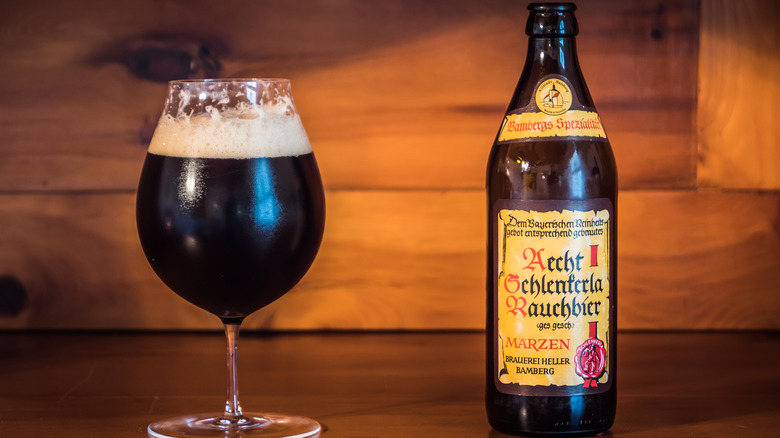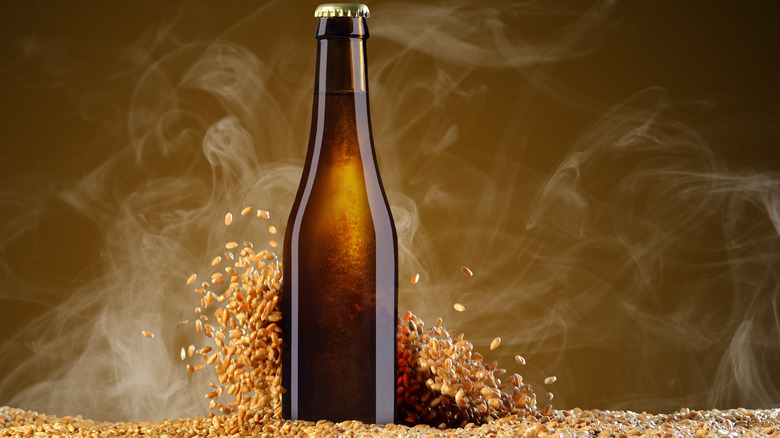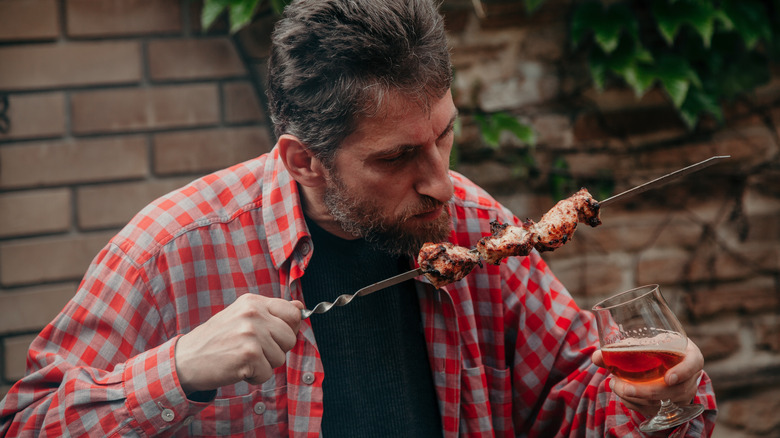Rauchbier: The German Beer With A Bold, Smoky Bite
If a roaring campfire and a pint of beer had a baby, you could call that child Rauchbier. Its bold bite hails from Germany, clutching in its fist a fiery pedigree that boasts a smoke-infused profile (rauch) found in anything from lagers to stouts (via The Takeout). But, like any brew that veers from the everyday go-to, folks have their opinions.
From ashtray licker to liquid bacon, diehards question such shade thrown at Rauchbier's Bamberger style, "We call it an account killer," Bill Wesselink of Chicago's Dovetail Brewery told The TakeOut, "We won't hear from them for another six months." Though, he soon recognized its cult following in 2017 when he started the Thank You For Smoking event, which transformed the taproom into a smoky beer lover's paradise and has remained popular over the years.
Liken to other German beer styles, Rauchbier is in a category all its own while wielding its weapon of choice — smoked malt, according to Jack van Paepeghem, Quality Manager at von Trapp Brewing in Stowe, Vermont. But, before you raise a pint to prost at your local taproom's trivia night, learning of its origins and methods can help you smoke your competition during a hearty round of Six Degrees of Kevin Bacon.
Where the Helles did it come from?
Rauchbier's recipe isn't as simple as water, barley, malt, and hops — the four ingredients to make beer outlined by the Reinheitsgebot (German purity law). The 1516 mandate protected beer from charlatans who corrupted what was considered a dietary staple of the time with potentially dangerous additives. Yeast and wheat were later approved, but smoke?
The smoldering legend spread from Bamberg, Germany where a medieval village fell in a fire leaving little more than malt found in the local brewhaus laced with the catastrophic smoke, according to Craft Beer & Brewing. As in any sordid tale, inspiration rose from its mythical ashes.
It could have been Daniel Wheeler's new kilning and malt technologies patented in 1818 that helped Rauchbier earn its own beer category, per Kegerator.com. Prior to Wheeler's invention, the perforated base of older kilns allowed the fire's smoke to penetrate the drying malt. This would have imparted a smoky palate and deeper shade to all brews, whether the brewer liked it or not.
To this day, there are a handful of breweries honoring days of olde by producing world-class Rauchbier. Perhaps the most renowned Rauchbier, Aecht Schlenkerla from Bamberg, dates back to 1405 and has won a myriad of awards since. The revered Alaskan Smoked Porter from Alaskan Brewing Company joins such ranks these days stateside, according to The Takeout.
What are its characteristics?
Rauchbiers encompass all beer made with smoked malts, but they are often made with helles lagers or porters as a base, per Wine Enthusiast. The color of the beer can range from amber to dark brown hues with a creamy head, per Absolute Beer.
The hardwood used in today's smoking process varies. Still, beech wood is the traditional choice, lending notes of smoky vanilla and honey. It's still used today by the OG of Rauchbiers – Schlenkerla, whereas the Alaskan Smoked Porter presents a robust body and a big smoky flavor by utilizing the brewery's local alder wood.
Though the smoke intensity depends heavily upon the brewer's craft, Rauchbier should present a well-balanced flavor of malty sweet with most often a dry finish. But, just say no to a pour that tastes burnt or charred. Because of its bacon nose, cigar aficionados often find Rauchbier a go-to pairing, as do those who enjoy a good BBQ joint. But, just like your 'cue, there's no room for greasy when it comes to the meatiness of this beer. Also, you might pick up a hint of hops, but don't bet on it.
As Rauchbier can be an acquired taste, take it from the master serving up grains of wisdom actually on Schlenkerla coasters, "Even if the brew tastes somewhat strange at the first swallow, do not stop, because soon you will realize that your thirst will not decrease and your pleasure will visibly increase."


